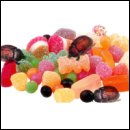5 Horrifying Food Additives You've Probably Eaten Today

Cracked.com's new book is now on sale. What follows is one of the classic articles that appear in the book, along with 18 new articles that you can't read anywhere else.
Deciphering food labels is tricky business. They're filled with lots of multisyllabic words that border on being impossible to pronounce, chemicals that sound like they could kill you just by touching them, and much, much worse. Read on, unless you've eaten recently ...
Shellac

Most everyone is familiar with shellac as a wood-finishing product. It's often used to give furniture, guitars and even AK-47's that special shine. But did you know it is also commonly used as a food additive? Yep, that's why those jelly beans you gorge on every Easter are so shiny.
But what exactly is shellac?
Are you sure you want to know?
Shellac is derived from the excretions of the Kerria lacca insect, most commonly found in the forests of Thailand.

The Kerria lacca uses the sticky excretion as a means to stick to the trees on which it lives. Candy makers use it to make those treats you love so much shiny and beautiful. Then you eat them. The insects that is.
 You see, the process used to harvest the Kerria lacca excretion is a pretty simple one. They just scrape that shit right off the tree. Unfortunately for you and your future enjoyment of shiny candies, this leaves little room for quality control measures to guarantee that the insects themselves aren't scooped up also.
You see, the process used to harvest the Kerria lacca excretion is a pretty simple one. They just scrape that shit right off the tree. Unfortunately for you and your future enjoyment of shiny candies, this leaves little room for quality control measures to guarantee that the insects themselves aren't scooped up also.
Before some health nut out there pipes up to tell us they don't eat candy, we'd like to point out that, during the cleaning process, apples lose their natural shine. Care to guess how it's restored?

If all of this is making you a bit queasy, we understand. It's not every day that you find out you've been celebrating the resurrection of Christ by consuming handfuls of insect-infused treats your entire life. But before you head to the medicine cabinet, consider this. That pill you want to take to quell your nausea? It didn't get shiny on its own. Alright, we swear, this is the last time we'll mention that you've been eating insects for a good majority of your life.
Bone Char

Some things are not as they seem. Just like Keith Richards appears to be alive but has really been dead for years, that sugar you put on your cereal in the morning isn't really white. Or at least it doesn't start out that way.
When it starts its sweet, delicious life, sugar is brown--a color deemed to be "undesirable" by the sugar industry. Don't be such racialists, sugar industry! To make their product more acceptable to whitey, sugar companies use a filtering process to strip it of its color. In some cases, the process is a typically boring one, using ions and such. But sugar derived from sugar cane (about a quarter of the sugar in the United States) goes through a ... different process.

Domino, the largest sugar producer in America, uses bone char to filter impurities from its sugar. Bone char is delightfully produced using the bones of cows from India, Pakistan and Afghanistan that have died from "natural causes," like when cows forget to wear a helmet when riding their motorcycles.
 The bones are bleached in the sun and sold to marketers who then sell them to the US sugar industry after they've been used by the gelatin industry. What the gelatin industry does with the bones, we don't want to know. The bones are then heated to the point that they become a perfect means of filtering sugar.
The bones are bleached in the sun and sold to marketers who then sell them to the US sugar industry after they've been used by the gelatin industry. What the gelatin industry does with the bones, we don't want to know. The bones are then heated to the point that they become a perfect means of filtering sugar.
We don't know by what alchemy this method purifies the sugar, we're certainly no scientists. But when you tell us that your purification method involves the ground-up bones of a sacrificed animal, well, we're just going to assume Satan is involved.
Carmine

Carmine can also be identified on food labels as Crimson Lake, Cochineal, Natural Red 4, C.I. 75470 or E120. We mention that because we're guessing you'll want to check for it in the future after reading this.
Oh, and that thing we said about how we'd stop mentioning that you eat bugs? We totally lied. If you're eating something red right now, or if you have recently, have a gander at the label.
 There is a strong chance it was made with carmine. And what's that? Are you sitting down?
There is a strong chance it was made with carmine. And what's that? Are you sitting down?
Carmine is made, literally, from ground-up cochineal insects, which is just a more harrowing way of saying mashed red beetles. Because you're dying to know more, the insects are killed by exposure to heat or immersion in hot water and then dried. Because the abdomen region that houses the fertilized eggs contains the most carmine, it is separated from the rest of the body, ground into a powder and cooked at high temperatures to extract the maximum amount of color.
Then, it's added to that yogurt you ate this morning while lording your health consciousness over the guy in the cubicle next to you who had an Egg McMuffin.

Carmine: Like a bucket of blood, except more disgusting.
But the carmine terror doesn't end there. Food manufacturers are well aware that word has gotten out about exactly what carmine is and that people are less than impressed about it. So a number of crafty manufacturers have resorted to labeling it not as carmine, but instead as "natural color," thereby guaranteeing you'll never really know for sure if your cherry ice cream contains the USDA recommended amount of creepy crawlers.
Nice. Hey, speaking of that ...
Natural Flavor

When it comes to food, most of us get nervous when people are intentionally vague. We steer clear of that street vendor selling "Meat Soup" and "Food Burritos."
So when you see that a label has included "natural flavor," you should be equally alarmed. If you're thinking the "natural flavor" in your orange candy must obviously come from oranges, think again. If it was from oranges, they would say so, right on the can. It would be a selling point.
 The problem is, natural flavor can, literally, be anything that isn't man made. Cat urine could be a natural flavor. If someone discovered that goat jizz added a special zing to ice cream and they could prove that eating it wouldn't make you sick ... natural flavor. We're not saying either of these are in your foods, but you get the idea.
The problem is, natural flavor can, literally, be anything that isn't man made. Cat urine could be a natural flavor. If someone discovered that goat jizz added a special zing to ice cream and they could prove that eating it wouldn't make you sick ... natural flavor. We're not saying either of these are in your foods, but you get the idea.
One potentially disturbing example of natural flavor gone bad comes from, where else, McDonald's. Back in 1990, amid constant public outcry about the amount of cholesterol in their french fries, McDonald's started using pure vegetable oil in their fryers.
Wait, what were they using before? Why, beef lard. When they stopped using it, and McDonald's realized fried potatoes don't taste as good without some molten beef added, it was "natural flavor" to the rescue.
When vegetarian groups demanded to know what the mystery flavor was, company reps would only say it was "animal derived."

They wouldn't say what animal. According to the book Fast Food Nation, "Beef is the probable source, although other meats cannot be ruled out. In France, for example, fries are sometimes cooked in duck fat or horse tallow." Horse. Tallow.
Hey, nothing unnatural about that!
Bacteriophages

In 2006, the FDA approved the use of bacteriophages to fight listeria microbes on lunch meat, wieners and sausages. If you're unfamiliar with the term "bacteriophages," let us put it in a layman's term for you. Viruses.
 In this case, six viruses, to be exact. There is an excellent chance that ham sandwich you had for lunch this afternoon was sprayed with a mixture of six different viruses in an effort to fight a microbe that kills hundreds of people a year. Hundreds. Approximately the same number of people that die in plane crashes. Because of this clear and present danger, your lunch meat is slathered with a buffet of viruses.
In this case, six viruses, to be exact. There is an excellent chance that ham sandwich you had for lunch this afternoon was sprayed with a mixture of six different viruses in an effort to fight a microbe that kills hundreds of people a year. Hundreds. Approximately the same number of people that die in plane crashes. Because of this clear and present danger, your lunch meat is slathered with a buffet of viruses.
This probably sounds bad enough already, but wait until you hear Intralytix, the company that developed the bacteriophage mixture, explain exactly how the virus works. "Typical phages have hollow heads that store their viral DNA and tunnel tails with tips that bind to specific molecules on the surface of their target bacteria. The viral DNA is injected through the tail into the host cell, where it directs the production of progeny phages."

We'll take it from here. The battlefield on which this virus vs. microbe war plays out is the bologna that you used this morning to prepare your afternoon lunch. Around the same time the hollow headed bacteriophages were storming the beach at listeria, you were lifting that bologna sandwich to your mouth. Just as the phages were thrusting their hollow, viral DNA-filled tails into the host cells (also living on your sandwich), you were jamming the whole nasty battle right down your oblivious gullet.
If you've ever tried the Subway diet without success, this might be a good time to give it another shot. If thinking about the rampant virus vs. microbe violence you're about to ingest doesn't put you off eating for the rest of the day then nothing will, tubby.
For more, go buy You Might Be a Zombie anywhere books are sold online or in person.
Adam hosts a podcast called Unpopular Opinion that you should check out right here. You should also be his friend on Twitter, Facebook and Tumblr.
For some equally unsettling foods you can be damn sure you've never eaten, check out The 6 Most Terrifying Foods in the World.